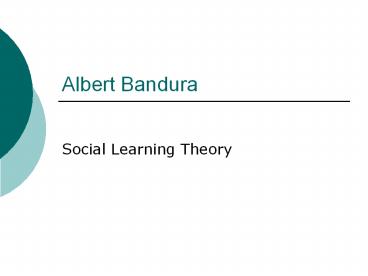Albert Bandura - PowerPoint PPT Presentation
1 / 15
Title:
Albert Bandura
Description:
Albert Bandura Social Learning Theory Social Learning Theory The idea that people learn from one another through observation, imitation, and modeling Reciprocal ... – PowerPoint PPT presentation
Number of Views:387
Avg rating:3.0/5.0
Title: Albert Bandura
1
Albert Bandura
- Social Learning Theory
2
Social Learning Theory
- The idea that people learn from one another
through observation, imitation, and modeling - Reciprocal Determinism The environment and a
persons behavior cause and reinforce each other.
3
Component Processes
- Attention
- Retention
- Motor Reproduction
- Motivation
4
Attention
- Different factors increase or decrease amount of
attention paid, such as - Distinctiveness of action
- Affective valence
- Complexity
- Functional value
5
Attention cont.
- Individual characteristics also affect attention
- Sensory capacities
- Arousal level
- Perceptual set
- Past reinforcement
6
Retention
- Remembering what you paid attention to,
including - Symbolic coding
- Mental images
- Cognitive organization
- Symbolic rehearsal
- Motor rehearsal
7
Reproduction
- Reproducing the image
- Physical capabilities
- Self-observation of reproduction
8
Motivation
- Having a good reason to imitate the action.
Motives include - Past (traditional behaviorism)
- Promised (imagined incentives)
- Vicarious (seeing and recalling the reinforced
model)
9
Principles of Social Learning
- Highest level of observational learning is first
organizing and rehearsing modeled behavior
symbolically, then reenacting it overtly. - Individuals are more likely to adopt a modeled
behavior if it results in valued outcomes - Individuals are more likely to adopt a modeled
behavior if the model is similar to the observer,
has admired status, and the behavior has
functional value
10
Bobo Doll Experiment (1961)
11
Method
- Selected children between 3-6 years old, evenly
distributed between sexes - Children placed individually in a room w/ toys
- 3 Groups
- Control no adult present with children, children
just played with toys provided for 10 minutes - Group 2 adult would verbally and physically
attack bobo doll - Group 3 adult played peacefully along with
children
12
Method Cont.
- Children were then taken to another room filled
with toys that they were not allowed to play with - Intended to build their frustration
- Children taken to a third room with aggressive
and non-aggressive toys as well as the bobo doll
13
Behavioral Factors Measured
- Physical Aggression
- Hitting doll with mallet, punching, kicking,
sitting on doll - Verbal Aggression
- General abuse
- Imitation of phrases used by adult model
- Other uses of mallet
- Aggression that was not a direct imitation of
adult model
14
Results
- Children exposed to non-aggressive model were
less likely to display aggression - Children exposed to aggressive model were more
likely to display aggression - Both physical and verbal
- Boys 3X more likely to display physical
aggression than girls - Verbal aggression levels were not significantly
different by gender
15
Results
- Aggression may be a learned behavior
- Suggests that avoiding displays of aggression may
reduce the liklihood of violent tendencies in
children - Still cited in debates about the effects of
violence in video games, movies, television, etc.































